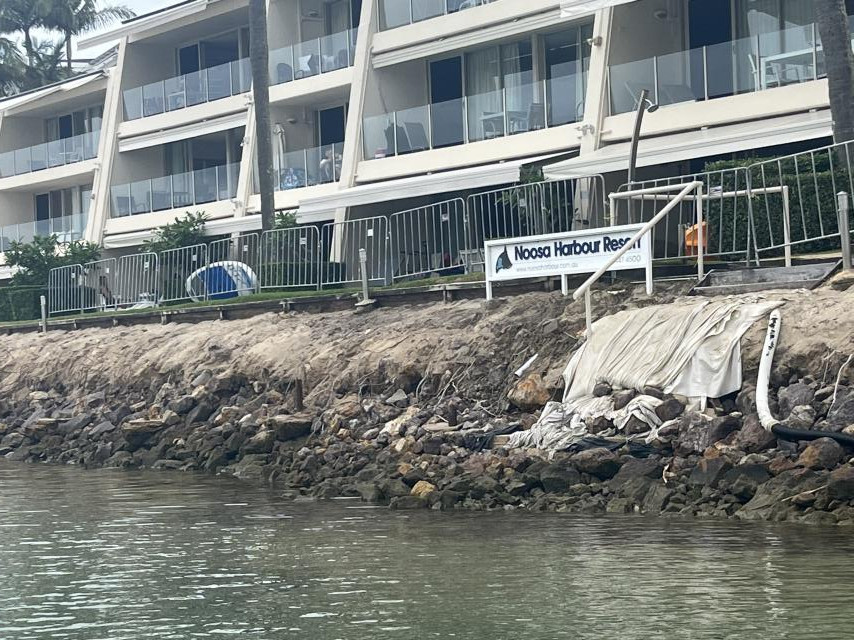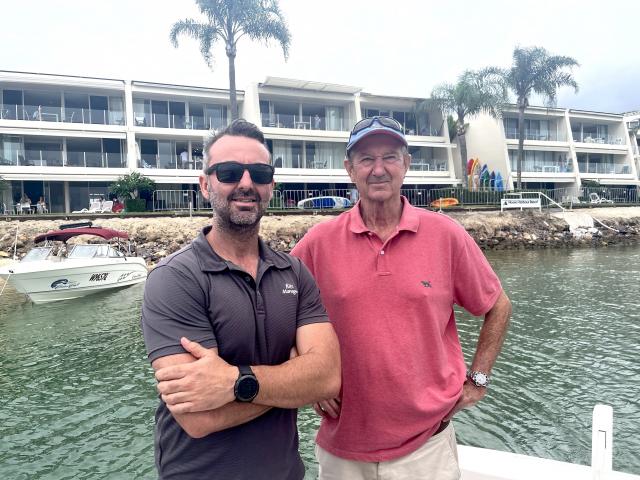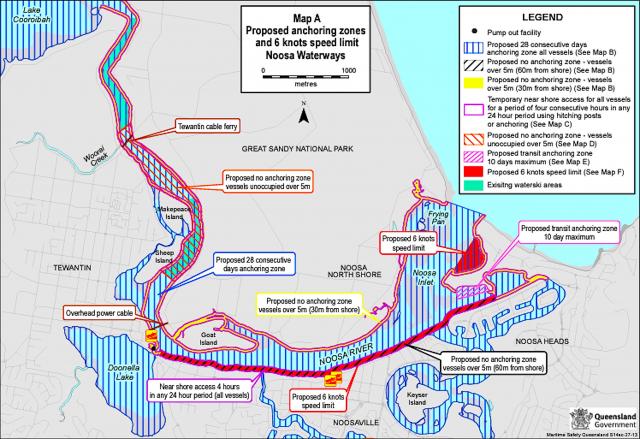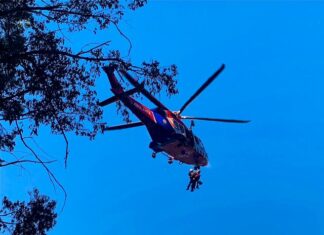The resort-studded foreshore of Culgoa Point is one of the prettiest parts of the lower estuary of the Noosa River and, not surprisingly, holidaymakers flock there year after year for its white sand river beach, glorious views and proximity to the restaurants of Quamby Place.
This season it’s been business as usual at Culgoa Point Beach Resort, tucked in where the main river meets Weyba Creek, but a mere 100 metres north along the shore it’s a different story.
At Las Rias and next-door neighbour Noosa Harbour Resort, guests look out from their riverfront rooms at a prison-style fence of crowd control barriers, placed there to prevent them from falling down a cliff into the rubble of a crumbling rock seawall where once was beach.
To say it’s been bad for business is to wildly understate the situation.
“It’s hard to put a figure on how much money we’ve lost through cancellations,” Ray Berridge, on-site manager for both resorts told Noosa Today.
“There’s been a lot of them, but we also have a very long waiting list so at this time of year we can fill them instantly. But we just had a ground floor guest tell us this week that she’s not coming back next year, and that would be a $6000 booking.
“If this continues into the quieter seasons I reckon we’ll lose hundreds of thousands. We’ve been frequently abused by angry guests, despite the fact that we sent out communications explaining the shoreline problems to all our regulars. Every second phone call and email we receive is about the lack of beach.”
While Ray attributes most of the foreshore washout to last year’s constant flooding, he says
wash from speeding boats has exacerbated the problem.
“Once you lose some of the beach, the problem just gets worse, especially with the excessive boat traffic we now have compared to a few years ago. The wash just keeps chiselling away at it.”
The cost of sand pumping is around $50,000 for Noosa Harbour Resort and $35,000 at Las Rias, and while there was no pumping last year because of the floods, it’s normally an annual event and in a bad year it might need two replenishments.
In addition to these costs, Noosa Harbour has had to undertake extensive jetty repairs because of the constant impact of large commercial boats speeding along the narrow channel.
Says Ray: “Part of that was because the channel has moved closer to the foreshore and we have these big fishing boats running right along our front at 20 knots.”
Noosa Sound neighbour and riverfront landowner Michael Storrer, who built his house and jetty more than 40 years ago, told Noosa Today that speeding in the Sound and Noosa Inlet was not only damaging infrastructure but endangering lives.
“The only option I can see is six knots all year round across the width of the river, which was what Maritime Safety Queensland proposed at the beginning of last year but they changed it.
“Years ago I put a lot of work into getting a four knot limit around the Sound and inlet and we were happy with that, but MSQ said there’s no such thing as a four-knot limit, but there is, and it’s at Mooloolaba. Now I think most people would be happy to see it at six knots but it has to be applied across the whole river.”
The Maritime Safety Queensland speed limits proposal was part of a broader river management community consultation survey which closed on 20 January, with an outcomes report anticipated next month.
The proposal outlines a year-round, six-knots-no-wash safety zone extending from the Lake Doonella bridge in Tewantin to the lower estuary.
However the zone is only 60 metres wide on the south shore and 30m on the North Shore, leaving a 20-knot highway down the middle in the wider stretches of the river, and unworkable situations in other places, like the Noosa Harbour Resort channel, where there simply isn’t 60 metres between foreshore and sand bar.
Although many veteran river watchers have welcomed the proposal (which they say is almost certain to be accepted) as “a good first step”, there is widespread criticism of its complexity and its prospects of enforcement.
One submission to MSQ from a riverfront resident seen by Noosa Today last week put in clear perspective the concerns expressed by many residents and riverside business owners: “MSQ’s latest recommendation of a 60m x 6 knot zone along the southern side of the river for 10 months of the year [adding to the existing two-month summer restrictions] is a definite improvement on what we have now, but it will fail to provide a safe and enjoyable environment long term for all river users, including humans and animals and the river’s foreshores (from needless wash damage).”
The writer goes on to explain: “The Noosa River is a series of narrow channels generally only 60m wide. These include the channel from Thomas Street to T-Boats [now Terrace Boats] between the red markers and the jet ski park, along Munna Point past the caravan park, the channel around the point of Quamby Place and the sand bank, and the channel around the point at The Woods and along the Dog Beach. Due to these narrow channels a permanent six-knot speed limit across the whole river would be a far more logical change long term.
“MSQ does not have the resources to adequately police the Noosa River throughout the year. The permanent six-knot speed limit across the whole river works really well during the Christmas and New Year period every year. It is very obvious who is speeding so the six-knot speed limit becomes self-enforceable.”
The writer goes on to echo the sentiments of many riverfront residents about the impact on the foreshore and its infrastructure of constant 20-knot wash from big boats. And while passive river users, like your correspondent, who have been forced to jump from their craft to avoid injury in holiday-time double-wash situations, might argue about the level of success of policing during high season, this submission clearly states the case being heard around the water coolers and the riverside bars: it’s time for a safer river.
As one river stakeholder summarised it for Noosa Today: “The current MSQ proposal for the speed limit is going to be adopted but as time goes on more and more people will realise that it’s not enough. All the jetties are getting smashed up, there’s safety to think about, it’s a huge issue and it’s not going to go away.”










